Abstract
The LES Project (LES-Llavor Energètica i Salut. Del cole a casa i a la societat, in English: Energy and Health Seed. From school to home and society) is seen as an opportunity to increase the visibility of the role of science and women scientists in their actual contexts and to present architectural research as essential in mitigating climate change and improving people’s health. The goal of this research was to reach the greatest range of people possible through intergenerational transfer. However, the main receptors and drivers were students aged between 8 and 10 years old who were responsible for transmitting energy and environmental conditioning concepts and their interrelations with strategic performance in buildings. Awareness was raised through scientific workshops implemented in primary schools that had energy and air quality deficiencies and opportunities, and the concepts were extrapolated to housing. Two schools in different socioeconomic districts (vulnerable and middle-income families) were selected as a strategy to provide details about the perceptions of energy benefits in both schools’ families. The results of the experience were highly satisfactory. Children from 8 to 10 years old were interested and ready to understand and transfer key concepts about energy efficiency and health improvement through the transformation of the buildings surrounding them. The dissemination of the project and social awareness reached the primary students of the two schools selected for the project and the entire educational community (students, teachers, families and all of society). Currently, we are working on a second stage that will allow for a broad volume of replicability of the workshops, with schoolteachers taking the lead in these actions. For this purpose, LES has the support of the Department of Education of the Generalitat de Catalunya.
1. Introduction
Urban areas characterised by a high density of buildings and by a significant period since construction require a deep renewal of their building stock to address the pressing challenge posed by the climate emergency. According to reports from the European Commission, approximately 75% of the EU’s real estate is inefficient, and only between 0.4% and 1.2% of buildings are renovated every year [1]. It is concerning that the ratio of the renovation of existing residential stock remains low despite the great global efforts that are being made. For example, the European Green Deal by 2050 establishes decarbonisation objectives or aids aimed at supporting these political strategies, such as Next Generation funds and local subsidies [2], which are a perfect complement to activate the dynamism of society and fuel energy improvement actions in their homes.
In large cities, most of the land is already built on, which makes it a priority to continue developing strategies and policies that promote and support energy improvements in buildings. For example, Barcelona has the oldest building stock in Spain. Homes in peripheral neighbourhoods have an average age of around 50 years. In the old town and nineteenth century expansion districts, the average age of buildings is over 100 years, which pre-dates the first Spanish thermal regulations of 1979 (NBE-CT-79) [3] and consequently the introduction of thermal insulation. Therefore, it is necessary to seize every opportunity to work on stimulus and awareness-raising initiatives in Barcelona aimed at promoting investment in and the activation of energy efficiency measures in homes and buildings. Communication campaigns on energy efficiency improvements often tend to focus on the energy, environmental or economic benefits, but they tend to overlook and underestimate the co-benefits of wellbeing and health [4,5,6].
People tend to focus more on addressing climate change or reducing energy bills than acting out of an awareness of the impact on comfort and health [7,8,9,10]. The EnerValor1 project highlights that people are more willing to carry out improvements on their homes for functionality and aesthetic purposes than for energy efficiency reasons. The findings of Rueda et al. [11], which were based on surveys, show that 70% of respondents recognise the implementation of sustainability criteria due to regulatory requirements rather than personal interest. Only 17.6% of respondents implemented energy efficiency measures due to an interest in energy benefits. EnerValor2 shows that people’s interest in energy-efficient rehabilitation focuses on very specific, partial actions. Sometimes, they are linked to active systems rather than the passive optimisation of the envelope [12]. People prioritise aesthetics and energy efficiency over comfort and health because aesthetic changes are easily noticeable, while energy improvements may not directly show health benefits due to complex interactions with other variables. Moreover, people are predisposed to carry out actions in the energy area if they have a figure who provides them with support in terms of technical, administrative and economic aspects to make such actions possible at the global level. Furthermore, a study by Vima-Grau et al. [13] indicates that the main deficiencies in the residential sector in the vulnerable neighbourhoods in Barcelona are linked to the building envelope and habitability conditions.
The public’s recognition of health effects resulting from aspects such as the hygrothermal behaviour of buildings and indoor air quality was heightened by the impact of COVID-19 [14]. This presents an opportunity to inspire individuals to take steps towards enhancing the living conditions in their households [15,16,17,18,19,20].
In addition to the aforementioned points, social interaction is a positive factor that promotes individual energy-saving behaviours [21,22,23,24,25,26]. Li et al. [27] stated that “low-difficulty energy-saving behaviours are susceptible to interpersonal and passive interactions, while high-difficulty energy-saving behaviours are susceptible to public relations and active interaction”. Similarly, when people are aware of the energy they consume and compare it to others’ consumption, they may be motivated to make adjustments and level up their energy efficiency.
Beyond traditional social communication processes, there is a growing emphasis on the intergenerational transfer of knowledge from children to parents [28]. This could be an opportunity to stimulate the adoption of energy renovation practices in the residential sector. In Belgium, Pearce et al. [29] conducted surveys with children aged 6–12. Their results showed that most of the children performed energy conservation measures out of personal preference or their willingness to conform to a set norm instead of producing an environmental impact. This was especially true among the older children. In China, Wang et al. conclude that in families with permissive, open parenting styles, children have a significant effect on their parents’ willingness to save energy, and children over the age of 18 appear to be effective in influencing parents’ willingness to invest in energy-efficient products [30]. Wang et al., also pointed out that energy-efficiency-promotion behaviour is influenced by individual psychological and city contextual factors [31]. This cross-knowledge and perception of the climate impact is not only evident at the energy level but also in fields such as conservation biology, where key practices of intergenerational learning are reviewed [32].
The LES project arose as an opportunity to share the LES team’s knowledge and scientific evidence on energy efficiency in buildings, covering various aspects such as user perceptions of benefits and co-benefits, technical and design perspectives on deep energy rehabilitation and sustainable school architecture, innovative interventions and energy poverty in metropolitan areas. It took advantage of a call from Barcelona City Council to promote education, culture and scientific outreach to a broader audience, particularly for those who are less familiar with the subject matter. In doing so, it aimed to prevent the potential decline of these scientific endeavours, which is commonly referred to as “Death Valley”.
The main objective of this project was twofold: to enhance the recognition of architecture as a discipline with significant scientific impact through representative figures of both sexes (three women and three men) and to raise social awareness about the benefits and co-benefits of energy-related actions in buildings, particularly in improving comfort and health.
This work was structured into three phases. The first phase focused on the design of a knowledge transmission model, which targeted children directly and engaged families indirectly through students. It also involved the establishment of energy-related concepts and scientific workshops and the integration of renewable energy sources while considering a social perspective that addressed socioeconomic levels, multiculturalism and gender. The second phase was the implementation phase, in which scientific workshops were held in a pilot school and in two demonstration schools in diverse neighbourhoods. Additionally, the web platform’s structure and content, tailored to potential recipients, was developed in this phase. The third phase was the qualitative assessment phase, in which the project’s objectives were validated through a focus group session with the team. This session assessed the relevance and effectiveness of the concepts and experiments in promoting energy awareness. The phase also evaluated the project’s feasibility and identified areas for improvement to achieve the desired outcomes.
Three in-person workshops were conducted, starting with a pilot school involving fifty students and subsequently expanding to two demonstration schools with the participation of two hundred students, resulting in a total of two hundred and fifty students and fifteen participating teachers. The workshops involved engaging experiments that explained 16 concepts related to energy and environmental conditioning.
Considering the household composition in the areas surrounding the schools, it is estimated that the potential replicability of the knowledge reached 265 families. The methodology developed in this project is expected to continue to be implemented in other schools and territorial contexts beyond Barcelona. This will be facilitated through the distribution of “scientific kits” to entities responsible for education and the support of the web platform.
2. Literature Review
Highlighting the potential contribution of science in the field of architecture offers an opportunity to present society with an alternative perspective on the impact of energy efficiency in residential buildings. For the successful implementation of the LES project, which targets students and families, an intergenerational communication model is essential. An active, cooperative learning model not only facilitates knowledge transmission to students but also transfers energy-related topics and opportunities to families, which fosters actions related to energy retrofitting. Scientific workshops were used to transfer this information to students, and a web platform was established to ensure accurate, extensive delivery to families. Furthermore, the project leveraged the presence of teachers to expand the social reach and raise awareness among them, to transfer the acquired knowledge to their homes and to stimulate them to incorporate it into their academic programmes or share it with their colleagues.
2.1. Energy Concepts Addressed in the LES Project Aimed at Enhancing Building Energy Performance
Children can act as effective agents for promoting energy-saving behaviours within families [33,34]. The EURONET 50/50 project offers an effective means of reducing energy consumption in buildings through the implementation of best use practices. Some projects exist that evaluate the impact of improvement measures in economic and environmental terms [35,36]. However, there is limited evidence of projects that focus on user awareness and education.
The European project ZEMedS centres on the architectural impact and energy behaviour of buildings coupled with good use practices [37,38,39,40] or ENoLL [41]. These projects involve all stakeholders (technicians, administrators and users) and aim to develop technical and financial toolkits for architects and technicians, provide mentoring for teachers and administrative staff and produce flyers and materials about good use practices for students. Regarding the concept of deep renovation, especially concerning an improvement in the energy efficiency of residential buildings and its impact on occupants, there is generally less awareness among younger audiences, who are a key target.
Through their research findings, the LES project team underscores the need to activate knowledge on building envelope vectors for energy improvement, considering usage patterns and seasonality. For instance, the EnerValor 2 project (Beyond the EPC requirements, potential and risks of energy efficient mortgages in the promotion of efficient homes. PID2019-104561RB-I00, MINCIU) found that Spanish adults were more aware of the benefits of upgrading heating or cooling appliances for better economic returns but less aware of passive strategies [12]. This may be attributed to the fact that these appliances need to be replaced more frequently due to their durability, and their intrinsic upgrade entails energy performance improvements driven by technological advances in the industry. But another component is the lack of awareness of passive energy strategies, which may also result from a lack of knowledge about building construction and building science. Schools, in particular, tend to prioritise conceptual understanding (e.g., solar radiation and heat gain) over practical implementation (e.g., shading devices and installation).
Energy envelope strategies for winter and summer seasons play a crucial role in the Mediterranean climate [42]. Factors such as solar radiation and ventilation throughout the year can create contradictions when design parameters are established. This design complexity can become an architectural challenge that leads to interesting strategies. For instance, performing a comprehensive evaluation of the design and management of solar shading devices management can help to modify thermal bridges in residential buildings and enhance their energy performance during winter. It also has significant potential to reduce or eliminate cooling demand during summer and sometimes makes the presence of mechanical air conditioning systems unnecessary.
The LES project aims to tackle the challenge of effectively communicating energy concepts related to building envelopes to children, who may perceive them as complex. The passive energy concepts addressed in the project include conductivity, thermal bridges, airtightness, solar radiation and the relationship of these concepts with occupancy and ventilation. The project informs children about the impact of these concepts on co-benefits such as health, wellbeing and comfort. Additionally, the project seeks to raise awareness about the importance of incorporating renewable energy sources (RES) in existing buildings as a key aspect to neutralise their energy consumption and thereby respond to the current climate emergency. The co-benefits associated with renewables go eyond their energy impact and include enhancing a building’s prestige and reputation at an individual level, creating new employment and business opportunities and alleviating energy poverty.
To ensure the clear understanding of the impact of energy concepts on buildings, analogies are established between energy concepts and common actions in everyday life. For example, energy loss through building envelope elements is explained through the analogy of a water bottle with holes. This comparison helps to illustrate the concept of energy inefficiency in buildings. Another analogy is made by relating the use of a thermometer to assess a patient’s health to the use of probes and instruments to measure the thermal comfort of a classroom. These analogies serve as effective communication tools to explain complex concepts and make them more understandable to younger students.
2.2. Social Perspective: Socioeconomic–Cultural–Gender
Another relevant social need that the project seeks to address is the promotion of gender diversity and the recognition of women’s contributions to science and construction fields that have historically been male-dominated. In addition, the selection of demonstration schools with culturally diverse families and varying socioeconomic backgrounds [43] serves as a social component that addresses inequalities and allows for cross-sectional results.
2.2.1. Short-Term Audience
- Students as direct participants;
This call was focused on the age range of 8 to 10 years, which corresponds to the middle cycle of primary education. This teaching stage was selected because it is the period when the development of skills such as oral expression and comprehension, socialisation, curiosity and logic are combined. According to Piaget’s theory, children between the ages of 7 and 11 begin to use logical thinking in certain situations, but they have not yet fully developed abstract thinking [44]. During this period, spatial, temporal and numerical concepts are introduced. Children also start to ask questions, predict the consequences of actions, consolidate their sense of responsibility and understand how phenomena are related. These skills are critical for the success of scientific activity aimed at understanding how energy performance in buildings is relevant in the context of climate change.
- Profile of demonstration schools. Intercultural and social perspective;
The schools selected for this project met two criteria: a high volume of multicultural population and location in socioeconomically diverse neighbourhoods, specifically vulnerable [45] and middle-income areas.
The school in a low-income neighbourhood in this study is characterised by a high proportion of students in vulnerable situations. The families in this district have structural and economic limitations (Table 1) that hinder their ability to undertake energy rehabilitation actions. This has a negative impact on their comfort and health. This project aims to challenge conservative cultural norms and promote women’s leadership. The school experiences a high student turnover due to its open enrolment model, with students coming from countries across four continents, including Honduras, Ecuador, Bolivia and Pakistan (which represent 9.1% of the inhabitants).

Table 1.
Profile of demonstration school’s people. Own elaboration based on idescat source [46].
The other school is located in a middle-income neighbourhood (Table 1), where affluent households have the capacity to invest in energy improvement actions and enhance the environmental quality of their spaces. The challenge in this neighbourhood is to motivate residents to take community-level energy actions, such as improving their building envelope and incorporating renewable energy sources. The foreign population in this area is primarily from Italy, China and France and represents 18% of the inhabitants, with residents from various countries across four continents.
- Teaching staff and families in student education as indirect participants.
The project not only educated the younger generations of our society, with 250 students involved, but also extended to their families. Notably, the current social model and the diversity of family units allowed reaching more than one family per child, which expanded the spread of the network [47,48]. By working in schools and engaging teachers (approximately 30 people), the project aimed to raise awareness of the importance and impact of energy improvements in residential and educational sectors among families and their close circle of friends.
2.2.2. Potential Future Audience
The importance of scaling the proposal to as many educational communities and contexts as possible was addressed by providing eight scientific suitcases, each accompanied by a corresponding user manual. In addition, alliances were fostered with schools and public administrations (Consorci d’Educació de Barcelona and Departament d’Educació de la Generalitat).
Another crucial aspect of social outreach revolves around teachers, who played a significant role as implementers in future schools. This involvement enabled them to enhance their skills and understanding of passive energy efficiency concepts in buildings along with renewable energy sources and their associated benefits and co-benefits. This empowered the teachers to incorporate these concepts into academic programmes that target younger age groups.
2.3. Active and Cooperative Learning for Two-Way Transmission of Knowledge
This project developed two-way transmission to effectively promote energy awareness. It involved direct awareness among the students through experimental scientific workshops, which enabled them to acquire building energy knowledge. Additionally, indirect awareness was built, as the students shared the knowledge they gained with their families, which was supported by the LES website.
2.3.1. Enhancing Knowledge Transmission: Experimental Scientific Workshops for Children Aged 8–10
The literature emphasises a need to develop active pedagogical models with children to enhance their understanding and retention of concepts [49,50,51,52,53,54]. By engaging students in hands-on activities and interactive experiments, this project aims to create a dynamic, immersive learning environment that promotes active participation and deepens understanding of energy concepts. This approach not only enhances students’ knowledge but also fosters their curiosity and critical thinking skills, which establishes a strong foundation for lifelong learning.
Pedagogical methodologies involving cooperative and active teaching were a driver for professional development within the LES research team’s experience [55,56,57,58,59,60,61,62]. Scientific experimental workshops were selected as the most suitable approach to provide a visual representation of scientific principles. In this approach, students take direct responsibility for the learning process while mentors play a supporting, advisory role. Scientific workshops were used to allow the students to experiment with energy efficiency concepts and to measure the impacts associated with them. The students manipulated objects to embody concepts such as measuring air quality or demonstrating renewable energy sources using photovoltaic-powered fans or the perceived temperatures of various materials. The students were encouraged to work together in groups, discuss their findings and learn from each another, which helped them to develop teamwork skills that were essential to promote collaborative, respectful interactions between the students in this project and in their future academic and professional careers.
This direct channel of transmission not only reached a larger number of students but also involved their teachers. The teachers had the opportunity to develop their skills and understanding of energy concepts. This empowered knowledge can be incorporated into their future academic programmes and can help them to assist colleagues in adapting the materials to their students’ specific needs. Furthermore, the teachers can apply these concepts in their own homes and share them with their immediate family, which can foster a culture of energy efficiency beyond the classroom. Ultimately, this collective effort can have a positive impact on society as a whole.
2.3.2. Intergenerational Transmission of Knowledge between Students and Families: Web Platform
To promote intergenerational communication between children and families and encourage the replication of these initiatives in new schools, this project leveraged the ongoing process of digitalisation. The widespread adoption of digital technologies has become a reality [63,64,65], including among children. This was partly accelerated by the COVID-19 pandemic, which made online education the primary pedagogical resource for maintaining learning without social contact [66,67,68,69,70].
Research has shown that digital pedagogy in schools tends to favour a hybrid model [71], particularly for older age groups like secondary school and university students [72,73]. This approach has been found to lead to improved learning outcomes for students, regardless of their socioeconomic background [74].
While the LES project utilised a web platform to enhance knowledge transfer and awareness at home, it is crucial to acknowledge the potential risks of an excessive reliance on digital tools [75,76,77,78,79,80,81,82,83], particularly for 8- to 10-year-old students. Therefore, the web platform was designed in a way that continued to promote practical and experimental activities instead of replacing them with a digital experience.
This intergenerational communicative model, supported by the web platform, actively involved households in the project. It fostered discussions among the students and their families on the energy performance of buildings, inspired by the activities carried out by the children. It also promoted information about the quality standards that should be demanded in the residential sector and information about opportunities and potential actions to renovate the housing stock. By creating awareness about potential deficiencies in their homes and offering additional information on improvement options, the project aimed to empower households to take proactive steps toward energy efficiency.
3. Methodology
The LES project emerged as an opportunity to showcase the potential impact of applied science in architecture to young generations through experimental workshops. It aimed to provide high visibility to women in traditionally male-dominated fields such as construction and science. The project’s strategy focused on integrating science as a concept, technique as a procedure and technology as a tool to create meaningful connections.
To ensure the effectiveness of its objectives and the transfer of knowledge, the project was divided into three phases (Figure 1): (1) novelty: the design of the experience, (2) the results and discussion about the concepts, the educational model and the potential for replicability, and (3) conclusions: the validation of the objectives and the reformulation of the initial design of the experience.
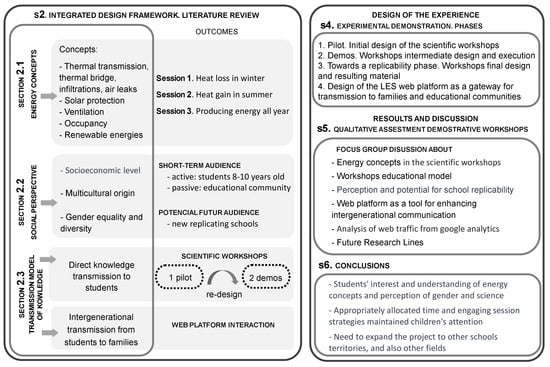
Figure 1.
Methodological approach. Instruments, basics and stages of study. Source: Self elaboration.
4. Experimental Demonstration
Once the guidelines for the experimental design model had been established, the scientific workshop was held in the pilot school. Based on the results obtained from this experience, some adaptations were made to ensure success in the two demonstration schools.
4.1. Pilot Phase: Initial Design of the Workshops
The student age group provided opportunities and limitations, such as attention span and the ability to assimilate multiple concepts. Therefore, during the design of the scientific workshops, the suitability of the pedagogical model was evaluated in collaboration with organisations specialised in educational innovation and research (i.e., CESIRE).
Initially, the project included nine energy concepts, as indicated in the first stage [84]. However, for the pilot test, these concepts were intertwined to create three sessions focused on the fundamentals of the law of the conservation of energy [85]: how to gain energy in summer, how to lose energy in winter and how to generate energy throughout the year (Figure 2). The pilot experience was conducted considering factors such as thematic focus, duration and location in line with the intended design.
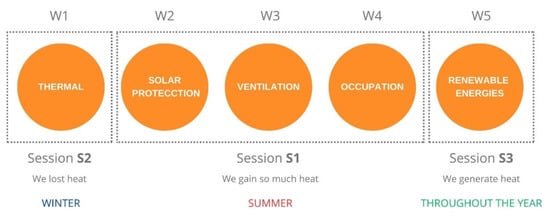
Figure 2.
Relationship between energy concepts and sessions. Source: Self elaboration.
In the initial testing phase, the proposed approach was applied in two classes of the pilot school (third grade class and fourth grade class) involving a total of fifty students. The results highlighted the pedagogical challenges associated with the use of digital tools among the students, including peer conflicts and decreased concentration levels, which affected the concept assimilation.
Consequently, it was decided to reduce the emphasis on digital tools and instead introduce data sheet templates for each topic, using digital tools in a selective, task-oriented manner. For example, the data sheet templates helped to promote a deeper understanding of the functions of the devices beyond their mere manipulation. Teams were also created with rotating group leaders assigned to each concept to ensure greater student engagement and participation (Figure 3).
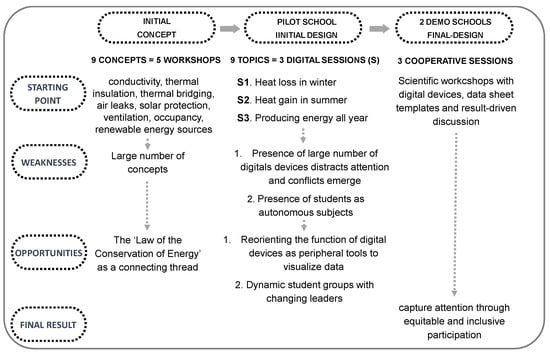
Figure 3.
Design phases of the scientific workshops. Source: Self elaboration.
To continue with the project’s de-digitalisation approach, a model based on the natural expressiveness of the students through images was devised to assess the impact of the workshops on the students. Instead of conventional surveys, the students were encouraged to create drawings that captured their learning and comprehension of the concepts. These creative outputs offered valuable insights into the concepts that resonated most with the students and how they interpreted and internalised the knowledge. Moreover, these drawings served as visual stimuli to engage families in exploring the project’s website and to inspire schools that could be interested in replicating the workshops. One remarkable example of a student’s creative output was a storybook (Figure 4) that beautifully captured the essence of the project, showcasing the integration of science in architecture. The authorship of the students’ drawings was carried out using their first names to preserve their privacy.

Figure 4.
Storybook by Carlota from Carlit School (CS).
The drawings contributed to raising awareness of the topics that had the most impact on the students and how they were interpreted. In some cases, a compilation of concepts from the first and third sessions was represented (Figure 5), while in other instances, the drawings showed topics in greater depth in one session (Figure 6, Figure 7 and Figure 8).

Figure 5.
Drawings showcasing mixed sessions concepts. From left to right: Liam from Ferrer i Guàrdia School (FGS), Fernanda from FGS and Anon. from Fort Pienc (FPS).

Figure 6.
Drawings showcasing concepts from session 1. From left to right: Sira from CS, Fernanda from FGS, Julia from FGS and Marc from FPS.

Figure 7.
Drawings showcasing concepts from session 2. From left to right: Anon. from CS, Maria from CS, Pol from CS and Wisdom from FGS.

Figure 8.
Drawings showcasing teamwork and datasheets. From left to right: Aicha from FPS, Safia from FPS, Libo from FPS and Sara from FGS.
As a common denominator, the drawings reflected the students’ assimilation of concepts such as teamwork (Figure 8), their active role in the workshop and their ability to understand the fundamental concepts conveyed (sun entering, water escaping and device for measuring things, among others).
4.2. Demonstration Phase of the Scientific Workshops: Intermediate Design and Execution of the Workshops
The demonstration schools phase involved the participation of a total of two hundred students divided among two third grade classes and two fourth grade classes per school. In total, the project engaged approximately 250 students, 15 teachers and over 265 potential families.
The workshops were conducted by pairs of members, consisting of one senior researcher and one researcher, with a focus on maintaining gender parity. The senior researchers brought their expertise in the field of architectural technology from the Barcelona School of Architecture. Although they were part of the same department, their individual specialisations covered various areas including conditioning and services, construction, rehabilitation and legal aspects of architecture. This wide range of expertise allowed for a comprehensive approach to the project, incorporating different perspectives and leveraging their collective knowledge.
The sessions were organised within a themed week entitled “energy efficiency and sustainability”, as defined by the school. The objective of the sessions was to provide content over three days.
- On the first day, the project was introduced by the lead researcher, who was a woman. The objective was to explain the significance of science in the field of architecture, with a particular emphasis on highlighting the role of women. The day concluded with the development of experiments in session 3 entitled “Producing energy all year round”.
- On the second day, all team members facilitated sessions 1 and 2. Session 1, entitled “Heat gains in summer”, focused on exploring the impact of three energy concepts: occupancy, ventilation and solar radiation. These concepts were demonstrated using sensors to measure air characteristics such as temperature, relative humidity and CO2 levels. Session 2, entitled “Heat loss in winter”, examined the impact of four energy concepts: conductivity, insulation, thermal bridging and infiltration.
- The third and final day was dedicated to evaluating the qualitative impact of the workshops. The participants were given a brief questionnaire to assess whether they had shared and communicated the activities with their family members, identify the concepts that had the most impact and create free-format drawings. As recognition of their participation in the workshops, the participants were awarded a scientific diploma that certified them as researchers of the project.
4.3. Towards a Replicability Phase: Final Design of the Workshops and Resulting Material
The final material package was created to enable autonomous replication by other schools in Barcelona during the initial stage. These materials were specifically designed to support the replication of the workshops and to ensure consistent, effective implementation across different schools. They included:
- Eight scientific suitcases (Figure 9): these suitcases contained the necessary materials for conducting the workshops and implementing the activities. They are currently stored at the headquarters of the Department of Education and Education Consortium to be provided to new schools interested in replicating the workshops.
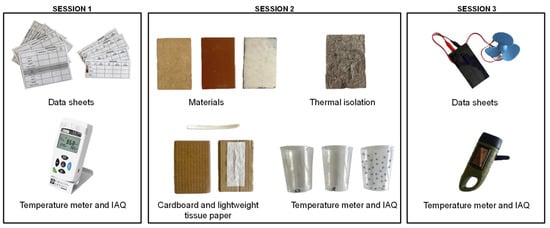 Figure 9. Scientific suitcase material. Source: Self elaboration.
Figure 9. Scientific suitcase material. Source: Self elaboration.
- Audiovisual user manual by session: each session was accompanied by an audiovisual user manual that provided guidance and instructions to implement the activities [86].
- Organisational charts (Figure 10): one organisational chart was included per session, outlining the structure and flow of the workshop activities. It can be used as a handy reference guide for future replication by teachers in other schools to promote the scalability and sustainability of the project.

Figure 10.
Organisational charts from the scientific sessions. Source: Self elaboration.
The following provides a detailed overview of the organisation and concepts addressed in session 2 (Figure 11), which corresponded to the session that covered the greatest number of topics and involved greater complexity, considering the age of the target audience. This session specifically focused on heat loss during winter and examined the concepts of conductivity, insulation, thermal bridging and infiltration.
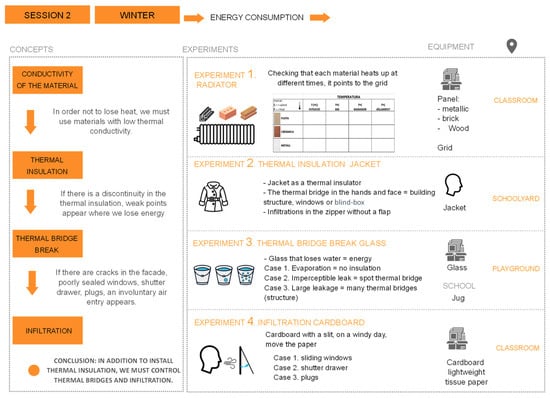
Figure 11.
Organisational chart, session 2. Source: Self elaboration.
4.4. Example of Structure and Content of Session 2
The session began by introducing the concept of conductivity through the most common building materials used in residential buildings (metal, wood and ceramic). The participants were prompted to think about which material would feel colder or hotter to the touch and to make an intuitive guess about which material would become hotter when placed on a radiator or behind a window with a high solar incidence.
To further explore this concept, an insulation layer was added between the radiator and the material, which surprised the participants with the realisation that the metal plate did not stay hot for long. Observations were recorded on a specific data sheet to facilitate further debate and reflection (Figure 12).
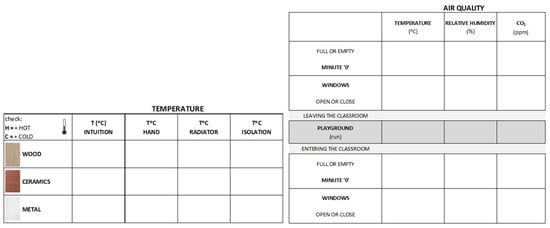
Figure 12.
Data sheets from sessions 1 and 2. Source: Self elaboration.
After visualizing the effectiveness of insulation in reducing energy transfer, the session moved on to discuss the impact of discontinuous insulation in the building envelope (thermal bridges).
To engage the participants and provide a mental break, a change in location from the classroom to the schoolyard was proposed. The change in location was accompanied by a physical activity, such as a 5 min run in the schoolyard, to increase the participants’ body temperature and make the impact of wearing a coat as a thermal insulator more evident.
The participants were asked to put on their jackets or coats (the activity took place on a relatively cold day) and become aware of the sensation of coldness on their face and hands, which represented the equivalent of a thermal bridge in a building (corresponding to the presence of a column, floor or balcony). This helped them to understand that just as they felt the cold on their face (indicating heat loss), buildings also experience similar heat loss when thermal bridges are present.
Given the complexity or level of abstraction of certain concepts (such as thermal bridges or air infiltrations), analogies were used, such as a bottle with holes in it, to emphasise the idea of energy losses in a building or the use of jackets with exposed or protected zippers to protect ourselves from the cold on the street.
By using these relatable examples and analogies, the session aimed to make the abstract concepts of thermal bridges and infiltration more tangible and understandable for the participants.
4.5. Design of the LES Web as a Gateway for Transmission to Families and Educational Communities
The final experimental demonstration and the LES project generated two main sets of materials: scientific suitcases with their support material and a web platform. Empowering families and communities through this platform is crucial to facilitate intergenerational knowledge transfer on the significance of energy rehabilitation in buildings. The LES platform was generated with information from the results of predecessor projects by the LES team (EnerValor, Smart Rehabilitation 3.0 [87,88], EnerValor 2 [89,90] and ZEMedS [91]) and new solar-tensed protections for sustainable educational architecture workshops [3].
The platform sections represent the target audiences of the project: students, families, potentially replicating schools and the students and their families, in addition to an introductory section that presents and contextualises the project itself.
In the initial phase, the web platform was divided into four sections: (1) technical guides to provide support information for children to understand the scientific concepts related to the energy efficiency and environmental conditioning of buildings, (2) social exchange between schools to discuss the scientific workshops, (3) gamification with game-like activities based on the scientific workshop concepts and (4) the dissemination of results through social networks.
After the demonstration phase and in line with the goal of promoting increased direct interaction between families and students, the “gamification” section was replaced with a “Knowledge Consolidation” section. In designing this section of the website, the flipped classroom model [92] was carefully considered as a valuable resource to stimulate debate, curiosity and learning among the students and their families.
The final outcome of the web platform is the “Introduction” section, which provides a general description of the LES project, while the “Resources” section provides families with information and guidance on the potential of energy rehabilitation, covering administrative, technical and economic aspects. The “Scientific Workshops” and “Knowledge Consolidation” sections offer resources to foster intergenerational communication between students and families, including videos of the workshops conducted in the three schools, photographs of the most significant moments and outcomes and a collection of drawings by the students representing the concepts that resonated most with them. Additionally, the “Schedule and Team Workshop” sub-section provides conceptual sheets that synthesise the contents and structures of the three sessions and serve as a support element to facilitate knowledge transfer from students to their families (Figure 13).
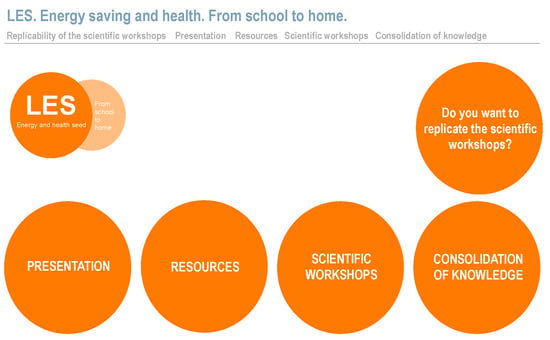
Figure 13.
Web platform structure and contents. Source: Self elaboration.
The “Will the Scientific Workshops be Replicated?” section provides resources for the autonomous replication of the workshops in new schools, including a summary of the workshop setup, three summary sheets that provide more detailed content and structure of each session in the user manual and contact information to obtain the necessary materials for replicating the experimental scientific workshops.
Currently, the website has introduced a new section called “Newsletter”, which will allow us to announce new stages of work and showcase the achievements obtained. For example, the project has received the UPC Social Commitment [93], which includes a financial reward to invest in the development of the project. This funding will be allocated to activate the content dissemination phase at the Catalan level to promote widespread replicability.
5. Qualitative Assessment of the Experimental Demonstration
Once the workshop model had been designed and implemented in the three schools, an evaluation process was conducted through a focus group involving all team members. The final survey generated for the final assessment enabled the evaluation of various thematic aspects, including quantity (minimal, adequate, excessive), difficulty (easy, appropriate, difficult) and specific parameter evaluation.
Figure 14 presents a summary of the overall assessment analysed. Red shading indicates low ratings, which were intentionally sought for certain aspects. For example, positive scores were observed for the activities that involved conceptual play within the same session, indicating no negative impact. Additionally, low ratings were recorded for the initial knowledge of the students and teachers, which was aligned with expectations. This underscores the importance of implementing an awareness plan through schools to promote energy efficiency in buildings, focusing on passive actions and renewable energies.
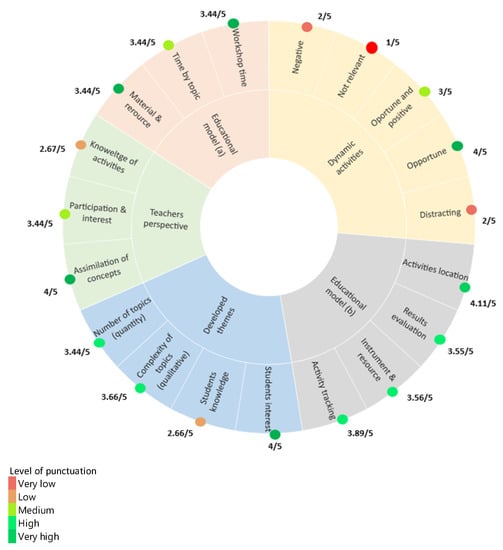
Figure 14.
Overall assessment analysed. Source: Self elaboration.
5.1. Energy Concepts in the Scientific Workshops
The evaluation encompassed the number of topics covered, their complexity, the students’ prior knowledge level and the level of interest shown. Using a scale from 1 to 5, the assessment gauged the lack or excess of each concept, with level 3 indicating a minimum or adequate level. All the analysed topics scored above the average value. The number of topics slightly exceeded the appropriate range. The complexity of the concepts, specifically designed for the target age range, was perceived to be high (rated 3.7), as anticipated in the project design (hence the inclusion of three thematic sessions focused on models of energy conservation). Notably, the students showed a low level of prior knowledge of the explained topics (rated 2.67), as announced in the project. However, the students’ interest level aligned with the expected outcome (rated 4), which validated the effectiveness of the pedagogical model designed for this purpose and demonstrated that these themes can be introduced at earlier ages to establish a stronger energy foundation of knowledge in the building sector.
To examine the results in greater depth, the complexity, knowledge level and interest of the students were analysed for each of the topics covered in the workshops (Figure 15). No topic reached an excessively high level of complexity according to the students’ skills. The topics that reached a higher level of complexity were occupancy, air quality, temperature evolution and renewable energies. The topics that were easier to convey and showed easy assimilation were the use of solar thermal energy to heat water in homes and two seemingly challenging topics: infiltrations and thermal bridges.
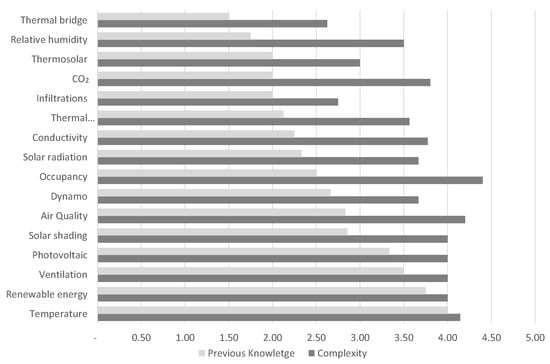
Figure 15.
Energy topics. Source: Self elaboration.
Regarding prior knowledge, it was observed that topics such as temperature, renewable energies and ventilation were familiar to the students, and they had knowledge above the level expected by the project team. The students had a lower level of knowledge about the remaining topics, including thermal bridges and air infiltration in buildings, as anticipated. However, the specific topic of CO2 content in the air was less predictable in terms of prior knowledge.
The interest in the experiments conducted in the workshops was high in all cases, as observed in Figure 16. Particularly notable were the experiments involving renewable energies, such as using fans and flashlights powered by photovoltaic panels, and those related to air quality, in which the students assessed the air quality conditions based on ventilation ratios and occupancy. Another experiment that sparked interest among the students was related to conductivity, in which the students measured the surface temperature of materials in contact with a heat source. Notably, the concept of thermal bridges, which was identified as somewhat complex, generated interest among the students when it was presented using the metaphor of a water glass.
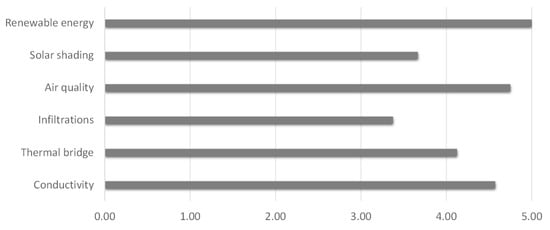
Figure 16.
Interest in experiments. Source: Self elaboration.
5.2. Workshop Educational Model
Quantitatively, the time dedicated to the sessions, the time allocated to each topic and the materials and resources used were evaluated. Additionally, a specific qualitative assessment was conducted on aspects such as the location of the activities and their impact on the workshop development.
Regarding the quantitative assessment, once again, a scale ranging from 1 to 5 was used to evaluate the lack or excess of each concept, with level 3 indicating an appropriate level. The overall results indicated that the time dedicated to the sessions was at an appropriate level (rated 3.11). However, the time allocated to each topic globally was slightly below the desired level (rated 2.78).
The utilisation of materials and resources in each workshop was analysed in relation to the students’ abilities (Figure 17) (1 = very agile, 3 = adequate, 5 = very complex), and an overall assessment close to the appropriate level was obtained, with a tendency towards elements that were highly intuitive and easy for the students to understand and operate, particularly those related to the workshop on renewable energies.
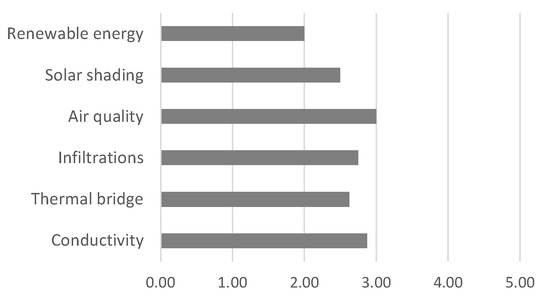
Figure 17.
Educational model. Material and resources vs. students’ skills. Source: Self elaboration.
On a quantitative level, the level of difficulty assessment indicated an overall tendency above the appropriate level, which did not reach the maximum level of difficulty in any case. However, further effort is required to align the content to facilitate its use and ultimately evaluate the results obtained.
Finally, opinions were collected regarding the location of the activities, that is, whether they were conducted inside or outside the classroom (schoolyard). The participants were asked to assess the appropriateness of the location, with 1 indicating inappropriateness and 5 indicating appropriateness. The results indicated that the evaluation tended to be highly positive, which suggests that the chosen locations were suitable for conducting the activities (rated 4.11).
Additionally, feedback was collected on the impact of the workshop dynamics and the decision to relocate certain activities from inside to outside the classroom. The results primarily indicated a positive and timely evaluation of this mobility (rated 4.11 out of 5). However, a slight distracting effect was perceived, which should be considered to complement it with a slight increase in the time allocated for the next activity in order to re-engage the students’ attention after the change in location.
The survey also provided the participants with an opportunity to respond to an open-ended question. In their responses to “Do you consider that other emerging elements can contribute optimally to the understanding of the topics covered?”, the participants highlighted the potential benefits of using scaled models of concepts such as infiltrations or thermal bridges, which enabled the students to associate the concept with a building model. They also suggested incorporating additional visual support, such as drawings on the board (for example, a conceptual section of a building to explain its actual location), videos or clue games to stimulate the students’ curiosity.
The incorporation of these new elements could enhance understanding and engagement among students, particularly when they address complex topics like thermal bridges and infiltrations. By providing tangible representations and interactive experiences, students can develop a deeper comprehension of these concepts and engage in the process actively.
5.3. Perception and Potential for School Replicability
According to the observations made at each school, the research team assessed the students’ perception of the workshop implementation and the potential for concept replication beyond the school context (Figure 18). Various aspects were evaluated, including the level and ease of comprehension of the concepts that were addressed, as observed in the students, the degree of interest expressed by the students, the need for concept repetition during the workshop, the level of participation and the potential for concept replicability by the students based on their acquired knowledge.
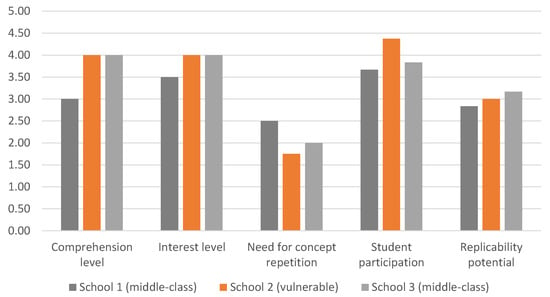
Figure 18.
Perception by school. Source: Self elaboration.
The results showed that the level of understanding and interest of the students in the topics covered in all three cases was above the value that was considered adequate. The need for concept repetition was low in all the demonstration cases (rated 1.85 out of 5) and slightly higher in the initial pilot school (rated 2.5 out of 5). Student participation exceeded the average value and tended to be high in all cases (3.7 out of 5 in middle-class-district schools), particularly in the case of the vulnerable neighbourhood school, where the ratio reached 4.38 out of 5. Regarding the potential for replicability observed from the students’ attitude, it was similar overall regardless of the school (rated 3 out of 5).
The results indicated that not all the teachers had appropriate prior information about the topics and content covered (an average score of 2.67 out of 5 was obtained, where 5 represents the maximum knowledge value). However, their participation during the workshops exceeded the average expectation in all cases (rated 3.44 out of 5). It was considered that the assimilation of concepts and the communication methodology employed was positive in all cases (rated 4 out of 5). Specific observations from the respondents served to confirm the differences in perception and participation of the schoolteachers in each case, considering that the involvement of the teachers varied significantly across the schools. For instance, in schools 1 and 3, some of the teachers were highly engaged and some were less participative (in a socioeconomically middle-class neighbourhood). However, in school 2 (in a vulnerable neighbourhood), this discrepancy was less pronounced.
5.4. Web Platform as a Tool to Enhance Intergenerational Communication
To discuss the adequacy of the web platform design, the following main aspects related to its structure and content, its potential for communication among students and families and its potential for communication among schools that could replicate the design were analysed (Figure 19).

Figure 19.
Web structure and contents. Source: Self elaboration.
The results obtained were positive in all four aspects. The content of the website was deemed helpful in facilitating and enhancing communication between the students and their families regarding the proposed topics and in promoting the replication of the workshops in new schools. The structure of the website was considered coherent with its educational and communication function beyond the school, and there was consistency between the objectives and the content. However, specific comments suggested that one area for improvement would be to emphasise the target audience of each section of the website. This enhancement is believed to make the website more user-friendly and able to encourage users to navigate through it (Figure 20).
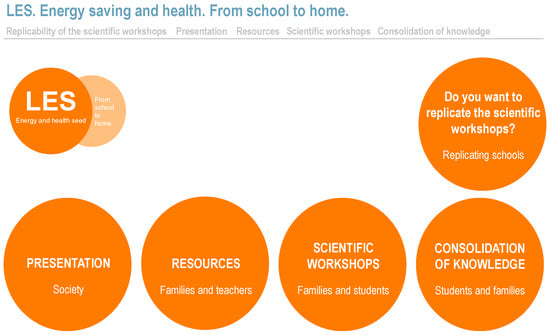
Figure 20.
Target audience of each section of the website. Source: Self elaboration.
5.5. Analysis of Web Traffic from Google Analytics
The website was designed as a support tool for knowledge consolidation among students and the promotion of intergenerational knowledge transfer within the family environment. This aspect made the potential users the families involved in the demonstrative phase described in this study, which included 250 students and 16 teachers.
To assess the level of activity on the website, the traffic statistics generated by Google Analytics were analysed. The total number of users was 369, which demonstrates that the website, as a tool for families to discuss and reflect on topics related to energy efficiency, comfort, health and others, functioned as expected. The nationality extended beyond local boundaries. This impact could be attributed, in part, to the diverse range of nationalities among the families of the demonstration schools. Specifically, visualisations from The Netherlands, Finland and the United States were observed during specific periods following the workshops with the students, the distribution of diplomas and the communication of the availability of videos and images showcasing the students’ participation in the workshops on the project’s website. Another key moment of increased national and international visualisations (including the United States and China) was attributed to the announcement of the fourth edition of the UPC Social Commitment award and its subsequent resolution, in which the LES project was recognised as one of the three winning initiatives (Figure 21). These data can be associated with the fact that the initiative generated a certain level of interest.
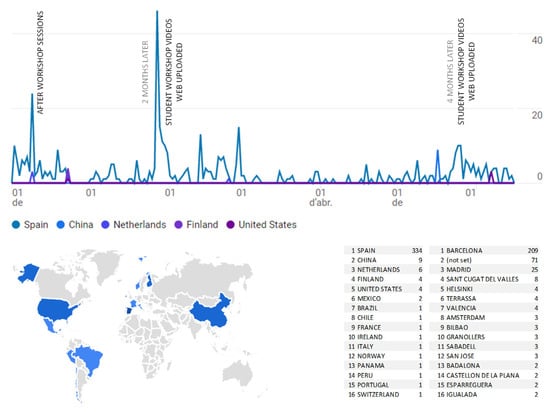
Figure 21.
LES web activity data from Google Analytics (last access June 2023).
The website analytics for the 6-month period revealed that most visualisations were concentrated in the “Presentation of the Project” section, with 921 views, followed by the “Scientific Workshops” section, with 346 views (Figure 22). It is important to highlight that the high volume of views on the homepage (in relation to the number of the initial target audience, 265 families) was a result of it being the contact link for the project, serving as the gateway to accessing the subsequent sections. Additionally, it is noteworthy that even though the replication phase for schools has not yet begun, the “Will the Scientific Workshops be Replicated?” section has already garnered 213 users.
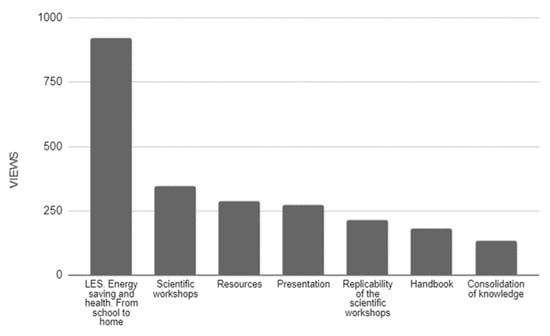
Figure 22.
Views of each section of the web.
5.6. Future Research Lines
The success of replicating this project hinges on teachers’ interest and skills in carrying out the scalability phase, as the project foresees teachers as the primary drivers of replication.
After completing and evaluating this initial demonstrative phase, efforts have commenced to activate a second phase of local replicability. The objective is to validate the adequacy of the toolkit and user manuals as tools to enable teachers to independently conduct the workshops.
For this local replicability stage, collaboration with the Department of Education of the Generalitat de Catalunya has been established, which oversees 2663 public kindergarten and primary schools (according to their own source). Based on the results, necessary adjustments will be made to enable broader replication through engagement with new educational entities at the national and international levels.
Another new phase will allow for the consolidation and optimisation of the methodology based on the feedback received and the expansion of the objectives to encompass more concepts and parameters beyond energy efficiency, working with other resources such as water, materials and waste.
6. Conclusions
This study provided communication and dissemination tools that allowed for the objective of designing a communication process on energy efficiency and co-benefits such as comfort and health, assimilable by 8- to 10-year-old students, who become amplifiers outside the school environment. From the development of the workshops to the generation of the educational materials for students to replicate at home and the creation of materials for teachers to replicate them periodically in schools, the web platform is a reference that provides information support for all potential audiences.
The methodology allowed for the identification of the most suitable topics, relevant communication tools, the necessary intensity and tracking indicators that validated the effectiveness of the communication strategy. The results of the surveys conducted with university teachers responsible for the workshops showed that the workshops were highly effective. It was observed that the students had little or no prior knowledge of the topics, except for temperature and renewable energy concepts (as shown in Figure 4, Figure 5 and Figure 6). The level of interest and understanding generated by the new concepts was generally extensive, with slight exceptions in complex concepts such as thermal bridges and infiltrations.
Consequently, it was determined that the key concepts related to building energy efficiency were received with interest and understood by the children in the indicated age range, which will likely lead to medium-term changes in educational planning in schools. The time dedicated to each session and topic was found to be appropriate, as were the changes in location during the sessions, which were timely to maintain the children’s attention. In the future, it would be interesting to quantify the knowledge acquired through regular activities, not only through tests but also through competitive and/or collaborative games.
A side note on a complementary topic is the perception of gender and science. The project workshops, which were mainly led by women with a PhD in architecture, served as a mirror in which many of the female students could see themselves and imagine themselves as scientists of the future. The reading of Hart’s book [94] (the translation of the original title into Catalan language is ’Les noies són capaces de tot’) also had an impact, which was reflected in a drawing that synthesised almost all the LES key concepts: conductivity, thermal bridges, IAQ data sheets, renewables and female leadership (Figure 23).
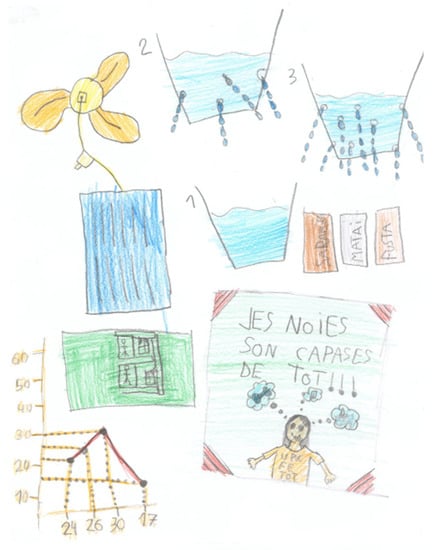
Figure 23.
Drawing by Júlia from FPS.
Once the communication methodology had been defined and validated through the workshops and the web platform with replicable and disseminable content had been created, the LES project entered a new phase, in which its deployment to other schools within the city and other interested territories is anticipated. The successful replication of this project hinges on the enthusiastic engagement and well-developed skills of teachers during the scalability phase.
Author Contributions
The term, conceptualisation, methodology, formal analysis, investigation, data curation, validation, review, editing, supervision and writing were carried out by: E.C.S., F.L.P., B.O.P. and C.M.-D. All authors have read and agreed to the published version of the manuscript.
Funding
Initially, the Ajuntament de Barcelona co-founded the LES-Llavor Energètica i Salut. Del cole a casa i a la societat through the Educació científica, cultura científica i divulgació a la recerca programme (22S02917-001). We acknowledge their support and collaboration in bringing this project to fruition. Currently, the UPC Social Council’s (Consell Social de la Universitat Politècnica de Catalunya) contribution will be instrumental in facilitating the dissemination of the project results within the primary academic sector, serving as a pathway to activate replicability in schools.
Data Availability Statement
The data presented in this study are available within the article.
Acknowledgments
The authors are grateful for the quality and prompt reception of the management team in the project schools: Escola Carlit, Escola Ferrer i Guàrdia and Escola Fort Pienc. The authors would like to express our gratitude to the EnerValor2 (Beyond the EPC Requirements, potential and risks of energy efficient mortgages in the promotion of efficient homes, PID2019-104561RB-I00, MINCIU) and Smart Rehabilitation 3.0 (Smart rehabilitation 3.0 innovating professional skills for existing building sector, 2019-1-ES0-KA203-065657, ERASMUS +) projects for their presence and valuable contributions. Their involvement was instrumental in establishing the foundation of this project and providing essential information to support our communication with the families.
Conflicts of Interest
The authors declare no conflict of interest.
References
- Gupta, J.; Chakraborty, M. Energy Efficiency in Buildings. In Sustainable Fuel Technologies Handbook; Academic Press: Cambridge, MA, USA, 2021; pp. 457–480. [Google Scholar] [CrossRef]
- Arbulu, M.; Grijalba, O.; Oregi, X. Analysis of Energy Retrofit Assessment Methodologies in Buildings by European Research Projects. Environ. Clim. Technol. 2021, 25, 265–280. [Google Scholar] [CrossRef]
- Anon. BOE-A-1979-24866 Real Decreto 2429/1979, de 6 de Julio, Por el que se Aprueba la Norma Básica de Edificación NBE-CT-79, Sobre Condiciones Térmicas en los Edificios. Available online: https://www.boe.es/eli/es/rd/1979/07/06/2429 (accessed on 22 June 2023).
- Hashempour, N.; Taherkhani, R.; Mahdikhani, M. Energy Performance Optimization of Existing Buildings: A Literature Review. Sustain. Cities Soc. 2020, 54, 101967. [Google Scholar] [CrossRef]
- Habibi, S.; Pons Valladares, O.; Peña, D. New Sustainability Assessment Model for Intelligent Façade Layers When Applied to Refurbish School Buildings Skins. Sustain. Energy Technol. Assess. 2020, 42, 100839. [Google Scholar] [CrossRef]
- Díaz-López, C.; Serrano-Jiménez, A.; Verichev, K.; Barrios-Padura, A. Passive Cooling Strategies to Optimise Sustainability and Environmental Ergonomics in Mediterranean Schools Based on a Critical Review. Build. Environ. 2022, 221, 109297. [Google Scholar] [CrossRef]
- Ürge-Vorsatz, D.; Herrero, S.T.; Dubash, N.K.; Lecocq, F. Measuring the Co-Benefits of Climate Change Mitigation. Annu. Rev. Environ. Resour. 2014, 39, 549–582. [Google Scholar] [CrossRef]
- Chapman, R.; Howden-Chapman, P.; Viggers, H.; O’Dea, D.; Kennedy, M. Retrofitting Houses with Insulation: A Cost–Benefit Analysis of a Randomised Community Trial. J. Epidemiol. Community Health 2009, 63, 271–277. [Google Scholar] [CrossRef]
- Marmolejo-Duarte, C.; García-Hooghuis, A.; Masià, A.G. How Much and Why Are We Willing to Pay for Energy-Efficient Homes? A Stated Preferences Analysis in Barcelona. Archit. City Environ. 2020, 14, 9215. [Google Scholar] [CrossRef]
- Biere-Arenas, R.; Marmolejo-Duarte, C.; Crespo-Sánchez, E.; Onecha-Pérez, B. Percepción de Beneficios y Co-Beneficios de Las Viviendas Energéticamente Eficientes. Un Análisis Para Barcelona. Rev. INVI 2023, 38, 260–290. [Google Scholar] [CrossRef]
- Rueda, A.L.; Ruiz, M.A.G.; Albaladejo, G.P. The Sustainability of Housing: Reasons to Encourage Its Development in Spain. REVESCO Rev. Estud. Coop. 2020, 133, e67334. [Google Scholar] [CrossRef]
- Crespo Sánchez, E.; Spairani Berrio, S.; Onecha Perez, B.; Marmolejo-Duarte, C. Perceived Benefits of Energy Efficiency in the Spanish Residential Market and Their Relation to Sociodemographic and Living Conditions. Appl. Sci. 2021, 11, 875. [Google Scholar] [CrossRef]
- Vima-Grau, S.; Cornadó, C.; Ravetllat, P.-J.; Garcia-Almirall, P. Multiscale Integral Assessment of Habitability in the Case of El Raval in Barcelona. Sustainability 2021, 13, 4598. [Google Scholar] [CrossRef]
- WHO. COVID-19. Available online: https://www.who.int/health-topics/coronavirus#tab=tab_1 (accessed on 22 June 2023).
- Megahed, N.A.; Ghoneim, E.M. Indoor Air Quality: Rethinking Rules of Building Design Strategies in Post-Pandemic Architecture. Environ. Res. 2021, 193, 110471. [Google Scholar] [CrossRef]
- Navaratnam, S.; Nguyen, K.; Selvaranjan, K.; Zhang, G.; Mendis, P.; Aye, L. Designing Post COVID-19 Buildings: Approaches for Achieving Healthy Buildings. Buildings 2022, 12, 74. [Google Scholar] [CrossRef]
- Agarwal, N.; Swaroop Meena, C.; Raj, B.P.; Saini, L.; Kumar, A.; Gopalakrishnan, N.; Kumar, A.; Babu Balam, N.; Alam, T.; Raj Kapoor, N.; et al. Indoor Air Quality Improvement in COVID-19 Pandemic: Review. Sustain. Cities Soc. 2021, 70, 102942. [Google Scholar] [CrossRef] [PubMed]
- Elrayies, G.M. Prophylactic Architecture: Formulating the Concept of Pandemic-Resilient Homes. Buildings 2022, 12, 927. [Google Scholar] [CrossRef]
- Spennemann, D.H.R. Architecture for a Post-COVID World. Buildings 2022, 12, 1537. [Google Scholar] [CrossRef]
- Wai Tham, K. Indoor Air Quality and Its Effects on Humans-A Review of Challenges and Developments in the Last 30 Years. Energy Build. 2016, 130, 637–650. [Google Scholar] [CrossRef]
- Crossley, N. Towards Relational Sociology; Routledge: Oxfordshire, UK, 2011. [Google Scholar]
- Sintov, N.D.; White, L.V.; Walpole, H. Thermostat Wars? The Roles of Gender and Thermal Comfort Negotiations in Household Energy Use Behavior. PLoS ONE 2019, 14, e0224198. [Google Scholar] [CrossRef]
- Bollinger, B.; Gillingham, K. Peer Effects in the Diffusion of Solar Photovoltaic Panels. Mark. Sci. 2012, 31, 900–912. [Google Scholar] [CrossRef]
- Allcott, H. Social Norms and Energy Conservation. J. Public Econ. 2011, 95, 1082–1095. [Google Scholar] [CrossRef]
- Kirst, E.; Schroth, T. A Framework to Enable Sustainability-Oriented Transition Activities in HEIs: Learnings from Two Case Studies in Germany and Switzerland. J. Clean. Prod. 2022, 379, 134605. [Google Scholar] [CrossRef]
- Domènech-Rodríguez, M.; Cornadó, C.; Vima-Grau, S.; Piasek, G.; Varela-Conde, A.; Ravetllat Mira, P.J. Co-Design and Co-Manufacturing: A Multidisciplinary Approach through Small-Scale Architectural Experiences in Barcelona. Buildings 2023, 13, 1159. [Google Scholar] [CrossRef]
- Li, H.; Wang, Z.H.; Zhang, B. How Social Interaction Induce Energy-Saving Behaviors in Buildings: Interpersonal & Passive Interactions vs. Public & Active Interactions. Energy Econ. 2023, 118, 106515. [Google Scholar] [CrossRef]
- Maquilón Sánchez, J.J.; Belén, A.; Ruiz, M.; Frutos, E.A.; Gualdo, A.M.G. Cambios Educativos y Formativos Para El Desarrollo Humano y Sostenible Coords; University Association for Teacher Training (AUFOP): Murcia, Spain, 2011. [Google Scholar]
- Pearce, H.; Hudders, L.; Van De Sompel, D. Young Energy Savers: Exploring the Role of Parents, Peers, Media and Schools in Saving Energy among Children in Belgium. Energy Res. Soc. Sci. 2020, 63, 101392. [Google Scholar] [CrossRef]
- Wang, J.; Long, R.; Chen, H.; Li, Q. How Do Parents and Children Promote Each Other? The Impact of Intergenerational Learning on Willingness to Save Energy. Energy Res. Soc. Sci. 2022, 87, 102465. [Google Scholar] [CrossRef]
- Long, R.; Wang, J.; Chen, H.; Li, Q.; Wu, M.; Tan-Soo, J.-S. Applying Multilevel Structural Equation Modeling to Energy-Saving Behavior: The Interaction of Individual-and City-Level Factors. Energy Policy 2023, 174, 113423. [Google Scholar] [CrossRef]
- Peterson, M.N.; Stevenson, K.T.; Lawson, D.F. Reviewing How Intergenerational Learning Can Help Conservation Biology Face Its Greatest Challenge. Biol. Conversat. 2019, 235, 290–294. [Google Scholar] [CrossRef]
- Leppilahti, M. Blogi Viestinnän Välineenä Case Euronet 50/50-Hanke; Vaasan Ammattikorkeakoulu. Vasa Yrkeshögskola. University of Applied Sciences: Vaasa, Finland, 2011. [Google Scholar]
- Pietrapertosa, F.; Tancredi, M.; Salvia, M.; Proto, M.; Pepe, A.; Giordano, M.; Afflitto, N.; Sarricchio, G.; Di Leo, S.; Cosmi, C. An Educational Awareness Program to Reduce Energy Consumption in Schools. J. Clean. Prod. 2021, 278, 123949. [Google Scholar] [CrossRef]
- Korsavi, S.S.; Jones, R.V.; Fuertes, A. Operations on Windows and External Doors in UK Primary Schools and Their Effects on Indoor Environmental Quality. Build. Environ. 2022, 207, 108416. [Google Scholar] [CrossRef]
- Mylonas, G.; Paganelli, F.; Cuffaro, G.; Nesi, I.; Karantzis, D. Using Gamification and IoT-Based Educational Tools towards Energy Savings—Some Experiences from Two Schools in Italy and Greece. J. Ambient. Intell. Humaniz. Comput. 2021, 1–20. [Google Scholar] [CrossRef]
- Manfren, M.; Aste, N.; Leonforte, F.; Del Pero, C.; Buzzetti, M.; Adhikari, R.S.; Zhixing, L. Parametric Energy Performance Analysis and Monitoring of Buildings-HEART Project Platform Case Study. Sustain. Cities Soc. 2020, 61, 102296. [Google Scholar] [CrossRef]
- Fahlstedt, O.; Temeljotov-Salaj, A.; Lohne, J.; Bohne, R.A. Holistic Assessment of Carbon Abatement Strategies in Building Refurbishment Literature-A Scoping Review. Renew. Sustain. Energy Rev. 2022, 167, 112636. [Google Scholar] [CrossRef]
- Gaitani, N.; Cases, L.; Mastrapostoli, E.; Eliopoulou, E. Paving the Way to Nearly Zero Energy Schools in Mediterranean Region-ZEMedS Project. Energy Procedia 2015, 78, 3348–3353. [Google Scholar] [CrossRef]
- Crespo Sanchez, E.; Ramon Dacosta Diaz, J.; Kampouropoulos, K. Novel Architectural Strategies to Support an NZEB Mediterranean School. In IOP Conference Series: Materials Science and Engineering; IOP Publishing: Bristol, UK, 2019; Volume 603, p. 042012. [Google Scholar] [CrossRef]
- Cosmi, C.; Pietrapertosa, F.; Sarricchio, G.; Giordano, M.; Proto, M.; Tancredi, M.; Salvia, M. Schools4energy: A Living Laboratory for Energy Awareness in Schools. In Proceedings of the Open Living Lab Days 2018, Geneva, Switzerland, 25 September 2018. [Google Scholar]
- Benincá, L.; Crespo Sánchez, E.; Passuello, A.; Leitzke, R.K.; Grala Da Cunha, E.; Maria González Barroso, J. Multi-Objective Optimization of the Solar Orientation of Two Residential Multifamily Buildings in South Brazil. Energy Build. 2023, 285, 112838. [Google Scholar] [CrossRef]
- Nguyen, L.; Duong, N.; Dinh, H.; Nguyen, M.; Nguyen, T. The Role of Parents on Their Children’s Academic Performance. Manag. Sci. Lett. 2021, 11, 747–756. [Google Scholar] [CrossRef]
- Piaget, J. The Origins of Intelligence in Children; International Universities Press: New York, NY, USA, 1952; Volume 8. [Google Scholar]
- Garcia-Almirall, P.; Cornadó, C.; Vima-Grau, S. Residential Vulnerability of Barcelona: Methodology Integrating Multi-Criteria Evaluation Systems and Geographic Information Systems. Sustainability 2021, 13, 13659. [Google Scholar] [CrossRef]
- idescat. Available online: https://www.idescat.cat/pub/?id=ist&n=14075&geo=mun:080193&lang=es (accessed on 22 June 2023).
- del Mar González, M.; Morgado, B.; Sánchez-Sandoval, Y. Diversidad Familiar y Escuela. Primera Evaluación Del Programa «Familias Diversas, Familias Felices. Cult. Educ. 2002, 14, 431–440. [Google Scholar] [CrossRef]
- Urdiales Bermúdez, I.; Caurcel Cara, M.J.; Crisol Moya, E. La Diversidad Familiar Desde La Perspectiva de Los Futuros Docentes de Educación Infantil: Necesidades Formativas. Rev. Complut. De Educ. 2021, 32, 349–359. [Google Scholar] [CrossRef]
- Froyd, J.E. Evidence for the Efficacy of Student-Active Learning Pedagogies; Texas A&M University: College Station, TX, USA, 2008; pp. 1–20. [Google Scholar]
- Hennah, N.; Newton, S.; Seery, M.K. A Holistic Framework for Developing Purposeful Practical Work. Chem. Educ. Res. Pract. 2022, 23, 582–598. [Google Scholar] [CrossRef]
- Marcia, C.; Linn, D.D.-H.L.G. Synergies between Learning Technologies and Learning Sciences, 1st ed.; Taylor&Francis Group: Abingdon, UK, 2023. [Google Scholar]
- Matuk, C.; Linn, M.C. Students’ Perceptions of the Impacts of Peer Ideas in Inquiry Learning. Instr. Sci 2023, 51, 65–102. [Google Scholar] [CrossRef]
- Mehta, S.; Kulshrestha, A.K. Implementation of Cooperative Learning in Science: A Developmental-Cum-Experimental Study. Educ. Res. Int. 2014, 2014, 431542. [Google Scholar] [CrossRef]
- Raviv, A.; Cohen, S.; Aflalo, E. How Should Students Learn in the School Science Laboratory? The Benefits of Cooperative Learning. Res. Sci. Educ. 2019, 49, 331–345. [Google Scholar] [CrossRef]
- Onecha Pérez, A.B.; Caballero Marcos, I.A.; López Valdés, D.; Sanz Prat, J. El Aprendizaje Cooperativo Aplicado a Las Asignaturas Técnicas Del 1r Curso de Arquitectura. In V Jornadas sobre Innovación Docente en Arquitectura (JIDA’17), Escuela Técnica Superior de Arquitectura de Sevilla, 16 y 17 de Noviembre de 2017: Libro de Actas; Grup per a la Innovació i la Logística Docent en l’Arquitectura (GILDA): Barcelona, Spain, 2017; pp. 176–189. [Google Scholar] [CrossRef]
- Onecha, B.; Bosch, M.; Bosch Prat, M.; Cornadó, C.; Crespo, E.; Martí, J. 4 X 4: Methodology to Design a Set Of 4 Moocs between 4 Entities under the Same Topic—Erasmus + Smart Rehabilitation 3.0 Project. In Proceedings of the 14th International Conference on Education and New Learning Technologies, Palma, Spain, 4–6 July 2022; pp. 2034–2040. [Google Scholar] [CrossRef]
- Onecha, B.; Cornadó, C.; Bosch, M.; Bosch Prat, M.; Crespo, E.; Pérez, A.; Cabrera, R.; Rosell, J.R.; Casanovas, X. Accompanied Self-Renovation: A Massive Online Course to Meet the Need of a Professional Rehabilitation Expert in People-Centered and Low-Cost Renovations. In Proceedings of the 14th Annual International Conference of Education, Research and Innovation, Online, 8–9 November 2021; pp. 1863–1869. [Google Scholar] [CrossRef]
- Onecha, B.; Cornadó, C.; Morros-Cardona, J.; Pons-Valladares, O. Interactive 360° website versus on-site visits for architecture students to achieve readiness in construction practice. In Proceedings of the 14th International Conference on Education and New Learning Technologies, Palma, Spain, 4–6 July 2022; pp. 3091–3096. [Google Scholar] [CrossRef]
- Cornadó Bardón, C.; Crespo Sánchez, E.; Martín García, E. Asignaturas Tecnológicas En Arquitectura En El Confinamiento: Hacia Una Enseñanza Aplicada. In VIII Jornadas sobre Innovación Docente en Arquitectura (JIDA’20), Escuela Técnica Superior de Arquitectura de Málaga, 12 y 13 de Noviembre de 2020: Libro de actas; Publicaciones y Divulgación Científica, Universidad de Málaga: Barcelona, Spain, 2020; pp. 175–185. [Google Scholar] [CrossRef]
- Pons Valladares, O. Actividades de Aprendizaje Para Sesiones Prácticas Sobre La Construcción En Arquitectura. In IX Jornadas sobre Innovación Docente en Arquitectura (JIDA’21), Escuela Técnica Superior de Arquitectura de Valladolid, 11 y 12 de Noviembre de 2021: Libro de actas; Universitat Politècnica de Catalunya. Iniciativa Digital Politècnica: Barcelona, Spain, 2021; pp. 249–260. [Google Scholar] [CrossRef]
- Pons-Valladares, O.; Hosseini, S.M.A.; Franquesa, J. Innovative Approach to Assist Architecture Teachers in Choosing Practical Sessions. Sustainability 2022, 14, 7081. [Google Scholar] [CrossRef]
- Onecha, B.; Cornadó, C.; Morros, J.; Pons, O. New Approach to Design and Assess Metaverse Environments for Improving Learning Processes in Higher Education: The Case of Architectural Construction and Rehabilitation. Buildings 2023, 13, 1340. [Google Scholar] [CrossRef]
- Skulmowski, A.; Rey, G.D. COVID-19 as an Accelerator for Digitalization at a German University: Establishing Hybrid Campuses in Times of Crisis. Hum. Behav. Emerg. Technol. 2020, 2, 212–216. [Google Scholar] [CrossRef] [PubMed]
- Haleem, A.; Javaid, M.; Qadri, M.A.; Suman, R. Understanding the Role of Digital Technologies in Education: A Review. Sustain. Oper. Comput. 2022, 3, 275–285. [Google Scholar] [CrossRef]
- Akcil, U.; Bastas, M. Examination of University Students’ Attitudes towards E-Learning during the COVID-19 Pandemic Process and the Relationship of Digital Citizenship. Contemp. Educ. Technol. 2020, 13, ep291. [Google Scholar] [CrossRef]
- Stoian, C.E.; Fărcașiu, M.A.; Dragomir, G.-M.; Gherheș, V. Transition from Online to Face-to-Face Education after COVID-19: The Benefits of Online Education from Students’ Perspective. Sustainability 2022, 14, 12812. [Google Scholar] [CrossRef]
- Gallego-Gómez, C.; De-Pablos-Heredero, C.; Montes-Botella, J.L. Change of Processes in the COVID-19 Scenario: From Face-to-Face to Remote Teaching-Learning Systems. Sustainability 2021, 13, 10513. [Google Scholar] [CrossRef]
- Keržič, D.; Alex, J.K.; Pamela Balbontín Alvarado, R.; Bezerra, D.d.S.; Cheraghi, M.; Dobrowolska, B.; Fagbamigbe, A.F.; Faris, M.E.; França, T.; González-Fernández, B.; et al. Academic Student Satisfaction and Perceived Performance in the E-Learning Environment during the COVID-19 Pandemic: Evidence across Ten Countries. PLoS ONE 2021, 16, e0258807. [Google Scholar] [CrossRef]
- Srisathan, W.A.; Naruetharadhol, P. A COVID-19 Disruption: The Great Acceleration of Digitally Planned and Transformed Behaviors in Thailand. Technol. Soc. 2022, 68, 101912. [Google Scholar] [CrossRef] [PubMed]
- Zawacki-Richter, O. The Current State and Impact of Covid-19 on Digital Higher Education in Germany. Hum. Behav. Emerg. Technol. 2021, 3, 218–226. [Google Scholar] [CrossRef] [PubMed]
- Farjana Shetu, S.; Mosfikur Rahman, M.; Ahmed, A.; Ferdousi Mahin, M.; Abtab Uddin Akib, M.; Saifuzzaman, M. Impactful E-Learning Framework: A New Hybrid Form of Education. Curr. Res. Behav. Sci. 2021, 2, 100038. [Google Scholar] [CrossRef]
- Rosak-Szyrocka, J.; Zywiolek, J.; Zaborski, A.; Chowdhury, S.; Hu, Y.-C. Digitalization of Higher Education Around the Globe During Covid-19. IEEE Access 2022, 10, 59782–59791. [Google Scholar] [CrossRef]
- Aristovnik, A.; Keržič, D.; Ravšelj, D.; Tomaževič, N.; Umek, L. Impacts of the Covid-19 Pandemic on Life of Higher Education Students: Global Survey Dataset from the First Wave. Data Brief 2021, 39, 107659. [Google Scholar] [CrossRef]
- Dey, P.; Bandyopadhyay, S. Blended Learning to Improve Quality of Primary Education among Underprivileged School Children in India. Educ. Inf. Technol. 2019, 24, 1995–2016. [Google Scholar] [CrossRef]
- Shcherbiak, I.; Kuzma, I.; Bilyakovska, O.; Binytska, K.; Halian, O.; Yankovych, O. Modern Information Technologies for Teaching and Control of Knowledge Acquisition of Older Preschoolers and Primary School Students. In Proceedings of the 2022 12th International Conference on Advanced Computer Information Technologies (ACIT), Ruzomberok, Slovakia, 26–28 September 2022; pp. 559–563. [Google Scholar] [CrossRef]
- Ciboci, L.; Labaš, D. Digital Media Literacy, School and Contemporary Parenting. Medijske Stud. 2019, 10, 83–101. [Google Scholar] [CrossRef]
- Šmit, M.; Biloš, A.; Strossmayer, J.J.; Turkalj, D. Internet Usage and Related Behavior Patterns of Primary School Children: Perceived Differences between Girls and Boys in Croatia. Ekon. Vjesn./Econviews—Rev. Contemp. Bus. Entrep. Econ. Issues 2021, 34, 307–317. [Google Scholar] [CrossRef]
- Žulec, A.; Varga, V.; Štefanić, L. Children’s and Parents’ Perspectives on the Effects of Children’s Digital Technology Use. Interact. Comput. 2022, 34, 73–84. [Google Scholar] [CrossRef]
- Wahyuningrum, E. Parenting in Digital Era: A Systematic Literature Review. J. Educ. Health Community Psychol. 2020, 9, 2460–8467. [Google Scholar]
- Coyne, S.M.; Radesky, J.; Collier, K.M.; Gentile, D.A.; Linder, J.R.; Nathanson, A.I.; Rasmussen, E.E.; Reich, S.M.; Rogers, J. Parenting and Digital Media. Pediatrics 2017, 140, S112–S116. [Google Scholar] [CrossRef] [PubMed]
- Eales, L.; Gillespie, S.; Alstat, R.A.; Ferguson, G.M.; Carlson, S.M. Children’s Screen and Problematic Media Use in the United States before and during the COVID-19 Pandemic. Child Dev. 2021, 92, e866–e882. [Google Scholar] [CrossRef] [PubMed]
- John, A.; Bates, S.; Zimmermann, N. Media Use and Children’s Self-Regulation: A Narrative Review. Early Child Dev. Care 2023, 193, 18–32. [Google Scholar] [CrossRef]
- Zhang, J.; Madigan, S.; Browne, D. Caregivers’ Psychological Distress, Technology Use, and Parenting: The Importance of a Multidimensional Perspective. Comput. Hum. Behav. 2022, 134, 107324. [Google Scholar] [CrossRef]
- Crespo Sánchez, E.; Onecha Pérez, B.; Pons Valladares, O.; Marmolejo-Duarte, C. Les-Energy Seed and Health. From School to Home. Towards a Model to Raise Awareness about the Benefits and Co-Benefits of Energy Retrofitting in the Residential Buildings. In Proceedings of the World Multidisciplinary Civil Engineering, Architecture, Urban Plannin, Prague, Czech Republic, 5–9 September 2022. [Google Scholar]
- Sarton, G.; Mayer, J.R.; Joule, J.P.; Carnot, S. The Discovery of the Law of Conservation of Energy. Isis 1929, 13, 18–44. [Google Scholar] [CrossRef]
- Manuals d’ús–LES. Estalvi Energètic i Salut. Del Cole a Casa—UPC. Universitat Politècnica de Catalunya. Available online: https://les.upc.edu/ca/manuals-dus/MU (accessed on 22 June 2023).
- Bosch, M.C.T.C.S.S.M. European Actions to Improve the Building Energy Efficiency: State of the Art of the Technical Standards. In Proceedings of the Archdesign’22/IX. International Architectural Design Conference Proceedings, Online, 6 May 2022. [Google Scholar]
- Montserrat Bosch González, T.C. Links for a Common Cultural Identity in The Mediterranean Basin. Int. J. Archit. Art Des. 2021, 10, 12–23. [Google Scholar]
- Espinoza-Zambrano, P.; Marmolejo-Duarte, C.; García-Hooghuis, A. Libro Del Edificio Electrónico (LdE-e): Advancing towards a Comprehensive Tool for the Management and Renovation of Multifamily Buildings in Spain. Sustainability 2023, 15, 2957. [Google Scholar] [CrossRef]
- Marmolejo-Duarte, C.; Biere-Arenas, R.; Spairani-Berrio, S.; Crespo-Sánchez, E. Las One-Stop-Shops Como Modelo Emergente En La Gestión de La Rehabilitación Energética En España. Ciudad. Y Territ. Estud. Territ. 2022, 54, 593–620. [Google Scholar] [CrossRef]
- Crespo Sánchez, E.; Cornadó Bardón, C.; Paris Viviana, O. Architectural and Environmental Strategies towards a Cost Optimal Deep Energy Retrofit for Mediterranean Public High Schools. Energy Rep. 2023, 9, 6434–6448. [Google Scholar] [CrossRef]
- Roehl, A.R.S.L.S.G.J. The Flipped Classroom: An Opportunity to Engage Millennial Students through Active Learning Strategies. J. Fam. Consum. Sci. 2013, 105, 44–49. [Google Scholar] [CrossRef]
- Blog—IV Premi UPC al Compromís Social—Decidim UPC. Available online: https://decidim.upc.edu/processes/IVPremis/f/2816/ (accessed on 22 June 2023).
- Hart, C.; Pye, A. Girls Can Do Anything, 1st ed.; Scholastic: New York, NY, USA, 2018. [Google Scholar]
Disclaimer/Publisher’s Note: The statements, opinions and data contained in all publications are solely those of the individual author(s) and contributor(s) and not of MDPI and/or the editor(s). MDPI and/or the editor(s) disclaim responsibility for any injury to people or property resulting from any ideas, methods, instructions or products referred to in the content. |
© 2023 by the authors. Licensee MDPI, Basel, Switzerland. This article is an open access article distributed under the terms and conditions of the Creative Commons Attribution (CC BY) license (https://creativecommons.org/licenses/by/4.0/).